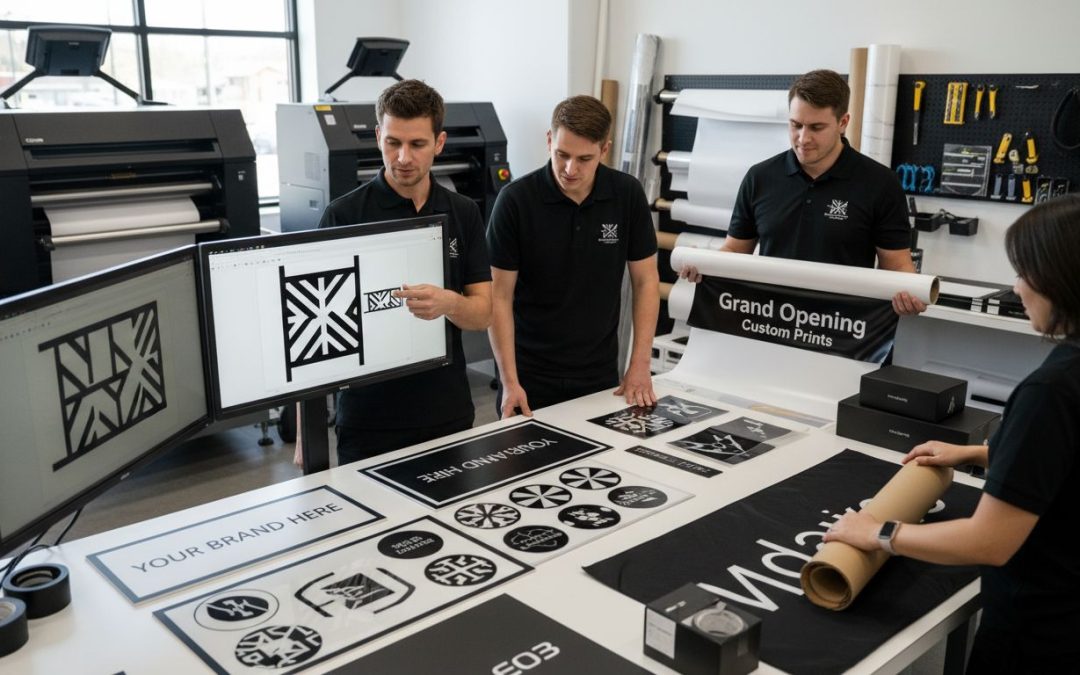{
“@type”: “Article”,
“author”: {
“url”: “https://customsignstoday.us”,
“name”: “Customsignstoday”,
“@type”: “Organization”
},
“@context”: “https://schema.org”,
“headline”: “What Is Custom Sign Printing? Complete Guide”,
“publisher”: {
“url”: “https://customsignstoday.us”,
“name”: “Customsignstoday”,
“@type”: “Organization”
},
“inLanguage”: “en”,
“articleBody”: “Discover custom sign printing in this comprehensive guide. Learn types, print processes, material options, costs, and industry uses for your business.”,
“description”: “Discover custom sign printing in this comprehensive guide. Learn types, print processes, material options, costs, and industry uses for your business.”,
“datePublished”: “2025-11-22T05:03:28.555Z”
}
Most american businesses rely on visual communication to connect with customers and stand out from the crowd. With over 80 percent of purchasing decisions influenced by signage and graphics, finding the right custom sign printing service can make a real difference. Whether you run a small shop or manage a growing company, understanding how modern printing options work helps you create signs that are not only eye-catching but also perfectly suited to your brand’s unique goals.
Table of Contents
- Defining Custom Sign Printing Services
- Types of Custom Signs and Applications
- How the Custom Sign Printing Process Works
- Material Choices and Design Considerations
- Costs, Turnaround, and Ordering Factors
Key Takeaways
| Point | Details |
|---|---|
| Custom Sign Printing Services | These services convert digital designs into tailored physical signs, using various advanced printing technologies. |
| Types of Custom Signs | Custom signs serve multiple purposes including retail, wayfinding, branding, and safety, making them versatile for any environment. |
| Printing Process | The printing process involves several stages, from design consultation to material selection, ensuring high-quality custom signs. |
| Cost and Ordering Factors | Key cost factors include sign size, design complexity, and material choice, with print-on-demand technology streamlining the ordering process. |
Defining Custom Sign Printing Services
Custom sign printing services are specialized graphic production solutions that transform digital designs into physical visual communication tools tailored to specific business or individual needs. Leveraging advanced printing technologies, these services enable organizations to create unique, professional signage that communicates brand identity, provides directional information, or serves promotional purposes.
According to Wikipedia, print-on-demand technologies have revolutionized custom printing by allowing materials to be produced precisely when an order is received, which means businesses can now obtain highly personalized signs without minimum quantity restrictions. This approach offers significant flexibility for organizations seeking targeted visual communication solutions.
Key characteristics of custom sign printing services typically include:
- High-resolution digital printing capabilities
- Multiple material options (vinyl, metal, plastic, canvas)
- Size and format customization
- Indoor and outdoor application support
- Quick turnaround times
These services go beyond traditional printing by offering comprehensive design consultation, material recommendations, and strategic visual communication support. By understanding client objectives, custom sign printing providers help transform conceptual ideas into impactful visual representations that effectively communicate messages across various environments. Learn more about designing effective custom signs in our guide on visual branding.
Types of Custom Signs and Applications
Custom sign printing encompasses a wide range of visual communication solutions designed to meet diverse business and organizational needs. These signs can be categorized based on their primary function, environment of use, and specific communication objectives. From small indoor directional signs to large exterior building signage, the versatility of custom sign printing enables businesses to create precise visual messaging.
Business applications of custom signs include:
- Retail Signage: Product displays, promotional banners, window graphics
- Wayfinding Signs: Directional markers, room identification, campus navigation
- Branding Signage: Lobby signs, reception area displays, corporate wall graphics
- Promotional Materials: Event banners, trade show displays, marketing posters
- Safety and Compliance Signs: Warning notices, regulatory information, instructional graphics
The material and design flexibility of custom sign printing allows organizations to create signs tailored to specific environments. Outdoor signs require weather-resistant materials like treated vinyl or aluminum, while indoor signs might use more delicate substrates like acrylic or canvas. Explore practical examples of how businesses leverage custom signage in our comprehensive guide.
Specialized sign types further demonstrate the breadth of custom printing capabilities.
 Vehicle wraps transform company transportation into mobile billboards, real estate signs provide critical property information, and temporary event signage can create immersive brand experiences. By understanding the unique communication needs of different sectors, custom sign printing services offer targeted solutions that go beyond traditional print media.
Vehicle wraps transform company transportation into mobile billboards, real estate signs provide critical property information, and temporary event signage can create immersive brand experiences. By understanding the unique communication needs of different sectors, custom sign printing services offer targeted solutions that go beyond traditional print media.
How the Custom Sign Printing Process Works
Custom sign printing transforms digital designs into tangible visual communication through a sophisticated, multi-step production process. This intricate workflow ensures that every sign meets precise client specifications and quality standards, from initial concept to final product delivery.
According to Wikipedia, the prepress stage is crucial, involving comprehensive artwork preparation, media selection, and rigorous quality control checks. This initial phase includes:
- Digital design refinement
- Color matching and proofing
- Material compatibility assessment
- File format optimization
Digital printing technologies have revolutionized sign production by enabling direct image transfer to various media with unprecedented speed and customization. Modern printing processes typically follow these key stages:
- Design Consultation: Clients collaborate with graphic designers to conceptualize their visual communication needs
- Digital File Preparation: Artwork is finalized in high-resolution digital formats
- Material Selection: Appropriate substrate is chosen based on usage environment
- Printing Execution: Advanced digital printers transfer designs onto selected materials
- Finishing: Signs are cut, laminated, or prepared for specific installation requirements
Learn more about designing effective business signs in our comprehensive guide. Each custom sign represents a unique blend of creative vision and technical precision, transforming digital concepts into powerful visual communication tools.
Material Choices and Design Considerations
Custom sign printing demands careful material selection and strategic design to ensure visual impact, durability, and functional effectiveness. According to Wikipedia, graphic design fundamentally involves creating visual communications that convey specific messages, which is critical in choosing the right materials and design approach for custom signs.
Material options for custom signs vary widely, each with unique characteristics:
- Vinyl: Flexible, cost-effective, ideal for temporary and indoor signage
- Aluminum: Lightweight, weather-resistant, perfect for outdoor and long-term applications
- Acrylic: Transparent, modern look, excellent for professional indoor displays
- Corrugated Plastic: Affordable, lightweight, suitable for short-term promotional signs
- Dibond: Composite material with excellent rigidity and smooth surface for high-quality graphics
Design considerations extend beyond material selection, encompassing critical elements like color psychology, typography, and visual hierarchy. Successful sign design requires balancing aesthetic appeal with readability and brand consistency. Factors such as viewing distance, lighting conditions, and environmental context play crucial roles in determining the most effective design approach.

Explore our comprehensive guide on designing business signs that boost visibility. The intersection of innovative materials and strategic design transforms custom signs from mere communication tools into powerful visual brand ambassadors.
Costs, Turnaround, and Ordering Factors
Custom sign printing involves a complex interplay of pricing factors, production timelines, and strategic ordering considerations that directly impact project outcomes. According to Wikipedia, digital printing technologies have revolutionized production by offering cost-effective solutions with remarkably quick turnaround times, particularly beneficial for businesses requiring flexible sign production.
Key cost determinants in custom sign printing include:
- Size of the sign: Larger signs typically require more materials and labor
- Complexity of design: Intricate graphics and multiple color processes increase production costs
- Material selection: Premium substrates like aluminum or specialty vinyl drive up pricing
- Quantity: Bulk orders often receive more favorable per-unit pricing
- Finishing requirements: Lamination, mounting, and special coating add to overall expenses
Print on demand technologies have further transformed ordering dynamics by enabling businesses to produce signs precisely when needed, reducing inventory costs and minimizing waste. Clients can now expect more streamlined ordering processes that include:
- Digital proof review
- Material and design confirmation
- Transparent pricing estimates
- Flexible production scheduling
Get a personalized quote for your custom sign project. Understanding these critical factors empowers businesses to make informed decisions, balancing budget constraints with high-quality visual communication needs.
Transform Your Vision into Powerful Custom Signs Today
Are you seeking tailored visual communication solutions that stand out and speak directly to your audience? This guide shows the value of custom sign printing from design to material choice and production stages. If you want to overcome challenges like selecting the right materials, ensuring durability for indoor or outdoor use, or creating impactful branding and promotional signs, our expert services at Uncategorized have you covered.

Explore the full potential of custom sign printing with CustomSignsToday.us, where quality meets customization. Our wide range of offerings includes banners, vehicle wraps, decals, and more crafted to suit your business needs and environment. Take control of your brand visibility and message clarity now by requesting a free quote or consulting with our design experts. Visit us to get started and bring your custom sign projects to life with confidence.
Frequently Asked Questions
What are custom sign printing services?
Custom sign printing services are specialized solutions that convert digital designs into physical visual communication tools tailored to the specific needs of businesses or individuals, offering flexibility and unique branding options.
What types of signs can be created with custom sign printing?
Custom sign printing can produce a variety of signs, including retail signage, wayfinding signs, branding signage, promotional materials, and safety and compliance signs, suitable for both indoor and outdoor applications.
How does the custom sign printing process work?
The custom sign printing process involves several key stages: design consultation, digital file preparation, material selection, printing execution, and finishing to ensure the sign meets quality standards and client specifications.
What materials are commonly used for custom signs?
Common materials for custom signs include vinyl for flexible and temporary signage, aluminum for weather-resistant outdoor signs, acrylic for a modern look, corrugated plastic for affordability, and Dibond for high-quality graphics and durability.
Recommended
- Custom Signs Today | West Palm Beach Sign Services
- How to Design Custom Signs for Impactful Visual Branding –
- Custom Signs Today | West Palm Beach Custom Printing | Florida
- Custom Signs Today | West Palm Beach Signs | Unique Signs
- What Is Custom Portraiture? Complete Expert Overview – The Family Portrait Companys

